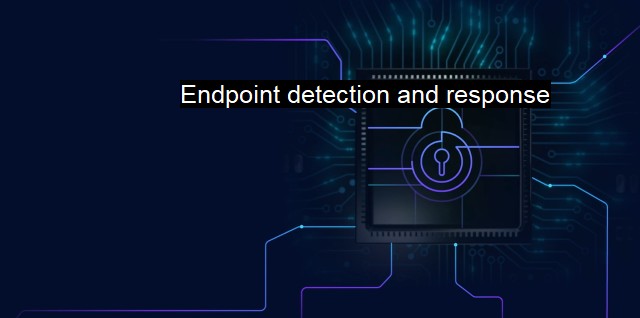What is Endpoint detection and response?
Endpoint Detection and Response (EDR): The New Wave of Cybersecurity for Endpoint Threat Detection and Remediation
Endpoint Detection and Response, frequently shortened to EDR, is a critical concept particularly focusing on network security. Its fundamental principle is to secure endpoints or end-user devices like smartphones, laptops, desktops, and servers from potential threats. Such other endpoint devices might involve IoT hardware or systems associated with client technology.Offering significantly more than antivirus solutions, EDR is a technology crafted based on the contemporary scheme of cyber threats. Considering the evolving landscape of cybercrime, traditional antivirus software might not be sufficient to protect IT systems from advanced, persistent attacks. This is where the role of a more updated and robust cyber defense mechanism like EDR becomes crucial.
At a primary level, EDR monitors endpoints and network events and archives this data in a central database where it is analysed for techno signatures of malware, anomalous activity, indicators of compromise, and other signs of attempted or successful breaches. In simple terms, it continuously recordings and stores the data related to endpoint activities enabling real-time automated response and later analysis to ward off any potential threats.
EDR provides end-users with the tools needed for forensic investigation to understand the entire chronicles of the cyberattacks and breaches. Therefore, EDR comes into play not only during attacks but also post-encroachment to analyze and learn from the incidents and thereby ameliorate the existing security system.
The policy of Endpoint Detection and Response takes inspiration from the techniques of incident response and forensics, thereby leading to the classification of two synergistic components: Detection and Response. Both are mutually inclusive and equally significant.
The Detection aspect primarily aims to discover potential threats, unusual behavior, and malicious activities occurring in the system or network. This is perpetually done by using a myriad of data collection methods, statistical analysis machineries, threat intelligence, and monitoring capabilities. Thereby, threats can be intercepted and identified in their early stages before they bring detrimental consequences to the system.
The Response in Endpoint Detection and Response, on the other hand, is the subsequent follow-up action once a threat is detected. These responses could range from sending alerts to system administrators to fully automated advanced actions like blocking malicious processes or isolating infected devices. The ultimate focus is to minimize the surface of attack immediately while a more comprehensive solution to counteract the threat is finessed.
What makes EDR solutions strong is their comprehensive and constant vigilance that reveals advanced risks and threats which are usually untraceable with traditional solutions, such as antivirus software. EDR harnesses the power of machine learning and behavioral analysis to detect anomalies and preemptively mitigate risks.
It is noteworthy to highlight that no single EDR solution offers a universal bombard against all cyber threats. Every business has refractory cyber needs that call for tailored approaches in their cybersecurity tactics. Consequently, businesses usually consider layers of defense mechanisms including firewalls, IPS/IDS, Endpoint Protection Platform (EPP), Managed Detection and Response (MDR), not excluding the invincible hackers’ favourite, the antivirus. Traditional security measures besides Bayesian and heuristic analyses are also coupled with EDR to aggregate and compound their cumulative efficacy towards a firm, strong shield against any cyber adversaries.
In the age where cyber threats have become ubiquitous and profound, Endpoint Detection and Response surfaces as a comprehensive and potent approach. As founded on the contemporary strategies of cyber defense and forensics, EDR delineates itself as a vital component in the arena of cybersecurity, paving the path for a safer and more secure digital universe.

Endpoint detection and response FAQs
What is endpoint detection and response (EDR)?
Endpoint detection and response (EDR) is a cybersecurity technology that provides visibility into endpoint activity on a network, and can alert security teams to suspicious behavior, anomalies or threats.How does endpoint detection and response (EDR) differ from antivirus software?
Antivirus software typically uses signature-based detection to identify known threats, while EDR solutions use behavioral analysis to detect anomalous activity and potential threats that are not yet known. EDR solutions also provide more granular visibility into endpoint activity, allowing for faster detection and response to threats.What are some common features of endpoint detection and response (EDR) solutions?
Common features of EDR solutions may include real-time monitoring of endpoints, threat hunting capabilities, automated incident response, machine learning and AI-based detection, and integration with other security tools like SIEM (security information and event management) platforms.What are the benefits of using endpoint detection and response (EDR) in cybersecurity?
EDR solutions can help organizations detect and respond to threats more quickly, reduce the impact of security incidents, and improve overall security posture. EDR can also provide detailed endpoint visibility and help security teams identify and remediate security gaps or vulnerabilities.| | A | | | B | | | C | | | D | | | E | | | F | | | G | | | H | | | I | | | J | | | K | | | L | | | M | |
| | N | | | O | | | P | | | Q | | | R | | | S | | | T | | | U | | | V | | | W | | | X | | | Y | | | Z | |
| | 1 | | | 2 | | | 3 | | | 4 | | | 7 | | | 8 | | |||||||